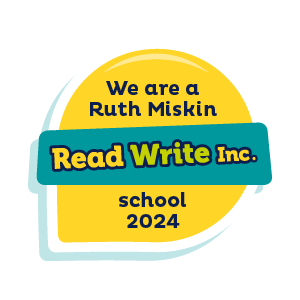Phonics
Intent
To create an inclusive, inspiring and challenging curriculum, which develops children’s knowledge of phonics, enabling them to become successful readers who develop a life-long love of reading. To ensure children in EYFS/KS1 are given the best opportunities to achieve expected progress, or more, in reading.
Implementation
In our school, phonics is taught across EYFS and KS1. We do this using the RWI programme of study. This is a scheme which provides a structured and systematic approach to teaching Phonics. It is designed to create fluent readers, confident speakers and willing writers. We teach in this way because research shows that when phonics is taught in a structured way, starting with the easiest sounds and progressing through to the most complex, it is the most effective way of teaching young children to read. According to the DfE (Department for Education), ‘almost all children who receive good teaching of phonics, will learn the skills they need to tackle new words’. They can then go on to read any kind of text fluently and confidently, and to read for enjoyment.

In our school we realise the importance of Phonics as it provides children with the building blocks needed to become successful readers. The children are taught how to recognise the sounds that each individual letter makes, identify the sounds that different combinations of letters make – such as ‘sh’ or ‘oo’ and then blend these sounds together, from left to right, to make a word. Children can then use this knowledge to decode new words they hear or see.
In Reception, the children learn the set 1 and set 2 sounds. Then in Year 1, children learn the 3 sounds, which enable them to read and write a range of words. Children learn different representations of a sound (‘graphemes’), for example ay, a-e, ai. This enables children to become more confident with not only their reading but also spelling and develops skills which are transferrable to their Literacy. In Year 1, there is a greater emphasis on the reading of the sounds, whereas in year 2 this progresses by using the graphemes more in spelling.
Across EYFS/KS1, children have daily phonics lessons which they enjoy. Each session is broken up into different parts including the teaching of a new sound, reading words with the new sound, revision of previous sounds/words and also spelling these words. Phonics is embedded across the curriculum and the children are encouraged to use phonics to support them in a range of topic work. Phonics is displayed in each RWI area across the school. The children are encouraged to use these displays to support their writing in all lessons across the curriculum.
Children in EYFS, Year 1 and 2 are assessed using the RWI assessments at the end of each term. The assessment identifies the progress made by each child. In addition to this, children in Year 1 are also assessed using a phonics screening check at least twice a year. Regular assessment using the phonics screening test, alongside the RWI assessment, enables us to group children for phonics/RWI, ensuring the teaching they receive is tailored to the level they are at. The final Year 1 phonics test takes place in June. The check is designed to confirm whether individual children have learned sufficient phonic decoding and blending skills to an appropriate standard. The test consists of 40 words – a combination of 20 real words and 20 pseudo words (nonsense words). This is carried out by the Phonics lead who has undertaken the phonics testing training and is someone who the children are familiar with. Children who do not pass this in Year 1, will be re-assessed in Year 2, in the same manner. The results of this are reported to parents in the summer.
Home reading books match our Phonics scheme and we use the RWI book bag books, which ensure continuity with our Phonics scheme. These are at the level of each individual child and match the books the children read in our Phonics lessons. Reading books are changed on the last day the book is taught in school. The Phonics leader also prepares and distributes phonics packs which contain the sounds that are taught on a daily basis. This allows parents to know what their child is learning, as well as secure the learning from school.
Impact
The result of phonics teaching at our school will be that children will have a secure knowledge of phonics, enabling them to become confident readers, making expected progress or more, with a life-long love of reading. Children will be able to apply their phonic knowledge to confidently spell many words either correctly or phonetically using the sounds they have learnt. They will know spelling alternatives for different sounds and be able to apply these consistently.
